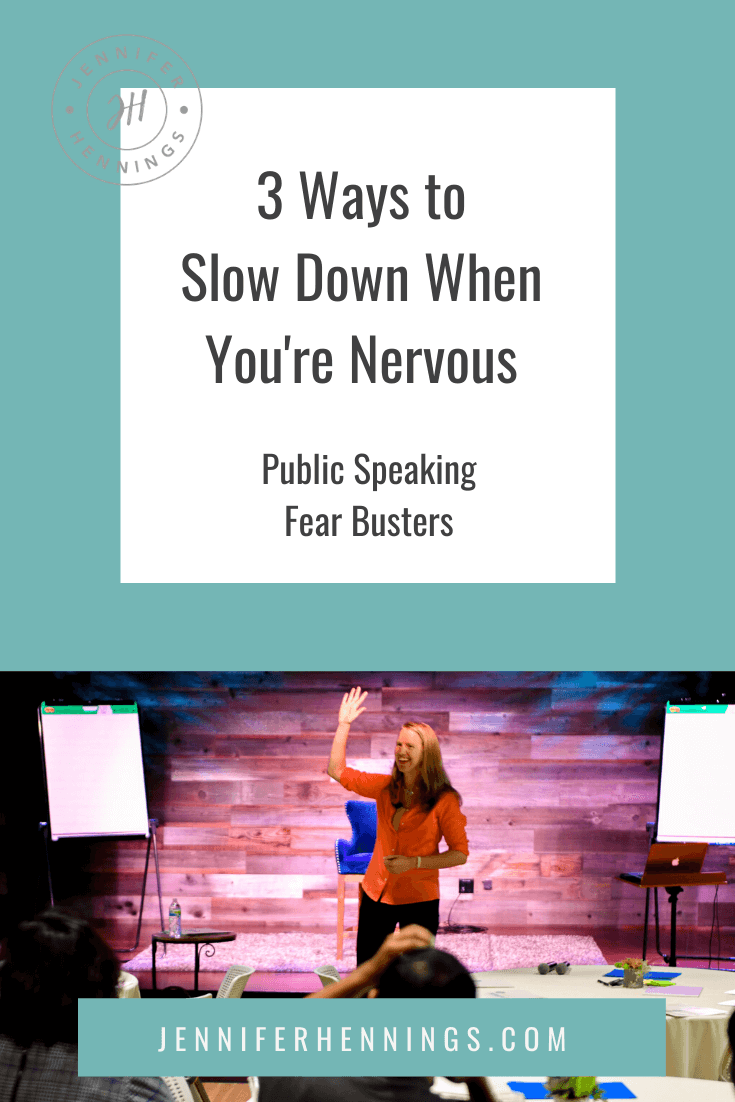If your public speaking fear makes you talk too fast, try these 3 tips to slow down and sound more confident.
If public speaking makes you nervous, maybe you've found yourself talking like this:
“HiI'mJenniferandI'mheretotalkaboutpublicspeakingandIhavetthreepointstomake…”
Sound familiar?
When you’re anxious or excited, it’s easy to talk too fast.
This topic is near and dear to my heart: I’ve struggled with speaking quickly my entire life, as have many of my clients.
It’s a common problem and a tough one to solve. But by the end of this article, you’ll know how to slow down so you can connect with your audience and give them a better sense of credibility and confidence.
Step 1: Know your baseline.
The first step to figuring out your pace is to know your baseline. You have to figure out: How bad is it, really? How fast are you actually speaking?
To do that, record yourself on video or audio as you're giving a presentation.
You can record a practice session—or better yet, record yourself giving a real presentation at work.
Then listen to it to see how you come across to an audience. There’s often a gap between how we think we look and sound and how we actually look and sound.
Step 2: Add PEP to your talk.
Once you know your baseline, it’s time to add PEP to your presentation: Pace check, Enunciation, and Pausing.
Pace check:
Learn to internalize what a good pace sounds like and how it feels in your body.
Now, this is a little tricky to understand. For me, what I've found is that when I feel like I'm speaking at a great pace, I'm going way too fast.
But when I do a pace check and it feels like my words are oozing out, like honey oozing slowly out of a jar, that's when I'm actually speaking at a good pace.
When I’m presenting, I’ll occasionally stop and ask myself:
Does my pace feel like oozing honey?
If so, I know I'm doing okay.
So use your video and your audio to figure out your pace check. Get a sense of what a good pace feels like in your body so that you can use a pace check when you're presenting.
Enunciation:
Enunciation means you’re crisply pronouncing every syllable of each word.
Here's what happens when you’re nervous and rushing: It’s easy to take a phrase like “customer engagement strategy” and blur it together so it becomes “customerengagementstrategy.”
Instead of rushing through your key phrases, I want you to picture them in bold, italic font.
That's your signal to slow down and enunciate each syllable.
So your “customerengagementstrategy” becomes your
“customer...engagement...strategy.”
Leave space between syllables and give each word some breathing room.
Pausing:
The second P in PEP is Pausing, which can be tough for those of us who get nervous.
Instead of rushing from one thought to the next, let there be a moment of silence as you transition between ideas.
One natural place to do this is if you're presenting with slides: Every time you change slides, pause and take a deep breath.
This pause is important for two reasons: One, it’s a chance for you to do your pace check and reset your pace. Two, it’s a chance for people to digest what you’re saying.
Remember, you’ve heard this material a million times while practicing, but your audience is hearing your talk for the first time.
Your listeners need pauses to process all this new information.
So when you’re rushing, add PEP: pace check, enunciation, and pausing.
Step 3: Enlist allies for help.
If you truly want to slow down and be a confident, clear speaker, the third step is to enlist allies for help in the workplace.
Slowing down is one of the hardest things for a nervous speaker to master. What often happens is you’ll add PEP and then for the first few minutes of your presentation, you’ll be great.
But as you keep speaking, it’s really easy for that faster pace to creep back in. And that's where you need feedback from trusted colleagues in the workplace to stay on track.
Maybe a colleague can give you a hand signal during your talk to remind you to slow down.
Or you can ask for real-time feedback right after an important meeting.
It can be tough to find people at work who’ll give you honest, constructive feedback about your public speaking style. That’s why speakers often seek help from a public speaking coach.
While coaching is a great help, I also encourage you to find a workplace ally who can give you on-the-spot feedback at work and support you on your quest to slow down.
Learning to change your pace is one of the toughest changes to make as a public speaker, especially if you’re nervous. But it’s a change worth fighting for.
Pace is a huge part of how you build confidence, credibility, and connection with your audience.
People won’t trust you or want to listen to you unless they can understand you.
So make sure you know your baseline, add PEP, and enlist your trusted allies so you can slow down when it counts and make a powerful impact next time you present.



